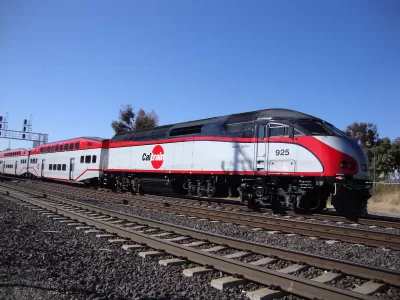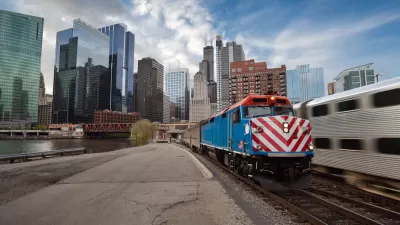Caltrain, the San Francisco-to-San Jose commuter railroad, plans to begin electrified operation next year on its 49-mile mainline. A 28-mile extension south to Gilroy would continue to be served by diesel trains, with one train powered by battery.

“In a first-in-the-nation move, Caltrain will pilot a Stadler battery equipped electric train that will operate on both electrified corridors and those without electrified lines, officials announced Thursday,” according to a San Mateo Daily Journal staff report on August 18.
“We’re excited to be the first in the nation to pilot this bi-level hybrid electric and battery service to extend our zero-emission service beyond our electrified service areas,” Caltrain Board Chair Jeff Gee said in a press release. “With the BEMU [battery electric multiple unit] we will not only create a more sustainable and environmentally friendly service, but also faster and more reliable travel times for riders.”
As a post almost exactly a year ago illustrates, when it comes to rail electrification in the U.S., there are lots of “firsts:”
- Alternative Railroad Electrification, August 28, 2022: “The Metra Board of Directors today approved a first-of-its-kind plan to convert up to six of Metra’s oldest diesel locomotives to zero-emission battery power...”
Update: “Metra’s plan to convert at least three of its oldest F40PH-3 diesel locomotives to battery power is on hold after the commuter operator was 'not able to secure an agreement' on a contract, Metra CEO/Executive Director Jim Derwinski said Friday,” reported Trains on February 20, 2023.
Also in that post was an update on a plan by the Long Island Rail Road more similar to what Caltrain is doing as it applies to electric multiple units, or EMUs, though powered by third rail.
Not a retrofit
Both Metra and LIRR electrification projects were based on retrofitting existing rolling stock, and that was blamed, in part, for the LIRR failure, as the post noted:
- LIRR officials said they are not giving up on the technology, and could incorporate it into the design of its next generation of train cars, the M9A, which remains several years away. [I.e., rather than retrofitting existing cars, it would consider purchasing battery-equipped EMU cars].
Caltrain, operating since 1863 on the San Francisco Peninsula, is in the process of converting from a diesel-powered commuter rail line to electrification via overhead line. Construction began in July 2017. [See Planetizen tag: Caltrain Electrification.]
“Caltrain is purchasing 19 new high-performance seven-car electric trainsets to replace the current diesel locomotive trains,” according to its website. Swiss-based Stadler is the manufacturer of these EMUs. The trains are being assembled at a former Union Pacific plant in Salt Lake City, Utah.
BEMU
The Daily Journal (source article) reports on August 18 that one additional, unique trainset will be purchased, thanks to state transportation officials. It is being viewed as a “as a demonstration train for expanded battery-electric intercity rail service in the future.”
The California Transportation Commission voted Thursday to move forward with the purchase of the single battery-equipped electric multiple unit train using funds from an $80 million award from the California State Transportation Agency [CalSTA].
“California continues to lead the transition to a clean, electrified transportation system, this time with the nation’s first battery-electric multiple unit [BEMU] passenger rail train,” said California Transportation Secretary Toks Omishakin in the Caltrain press release. Funds come from CalSTA's Transit and Intercity Rail Capital Program.
Dual mode
To be clear, BEMUs can be called 'hybrids' in the sense that they can draw power from overhead lines, also called catenary wire, while recharging their batteries, as Stadler explains for the FLIRT [Fast Light Intercity and Regional Train] Akku model.
On sections with overhead lines, the trains powered by electricity can charge the batteries from pantographs and through regenerative braking. Where the contact wire ends, journeys can be continued in battery mode.
A better term is “dual mode,” as Caltrain explains in their press release.
The demonstration of this technology has wide-ranging benefits for rail operations throughout the country. There are currently no bi-level off-wire battery dual mode commuter trains in operations in the United States, and the potential of this technology could make the transition to electrified service easier for other operators by not requiring full overhead line coverage throughout entire train corridors.
Railway Age also reported on the demonstration BEMU train and included a comprehensive update on the Caltrain electrification project and Stadler's plans for its FLIRT Akku model.
FULL STORY: Caltrain to pilot bi-level dual electric, battery powered train

Planetizen Federal Action Tracker
A weekly monitor of how Trump’s orders and actions are impacting planners and planning in America.

Map: Where Senate Republicans Want to Sell Your Public Lands
For public land advocates, the Senate Republicans’ proposal to sell millions of acres of public land in the West is “the biggest fight of their careers.”

Restaurant Patios Were a Pandemic Win — Why Were They so Hard to Keep?
Social distancing requirements and changes in travel patterns prompted cities to pilot new uses for street and sidewalk space. Then it got complicated.

Platform Pilsner: Vancouver Transit Agency Releases... a Beer?
TransLink will receive a portion of every sale of the four-pack.

Toronto Weighs Cheaper Transit, Parking Hikes for Major Events
Special event rates would take effect during large festivals, sports games and concerts to ‘discourage driving, manage congestion and free up space for transit.”

Berlin to Consider Car-Free Zone Larger Than Manhattan
The area bound by the 22-mile Ringbahn would still allow 12 uses of a private automobile per year per person, and several other exemptions.
Urban Design for Planners 1: Software Tools
This six-course series explores essential urban design concepts using open source software and equips planners with the tools they need to participate fully in the urban design process.
Planning for Universal Design
Learn the tools for implementing Universal Design in planning regulations.
Heyer Gruel & Associates PA
JM Goldson LLC
Custer County Colorado
City of Camden Redevelopment Agency
City of Astoria
Transportation Research & Education Center (TREC) at Portland State University
Camden Redevelopment Agency
City of Claremont
Municipality of Princeton (NJ)



























